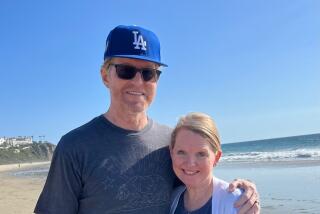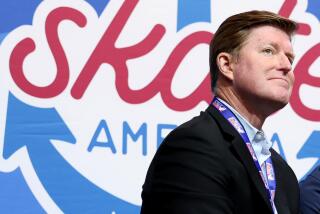BOBBY ORR : Once Best on Skates, He Walks With Pain
BOSTON — It used to be a knee. It bent and absorbed shock the same way most people’s knees do. But that was a long time ago. Today, the area halfway between Bobby Orr’s left ankle and left hip is not so much a knee as it is a barometer.
When the weather changes in New England, as it has a tendency to do every 30 minutes or so, Orr knows it without having to glance outside.
Rain causes an ache. Snow brings a sharper pain.
It is getting worse, too. Orthopedic surgeons have told Orr that without a radical operation to replace what’s left of his knee joint with an artificial hinge, rain and snow will be the least of his problems.
In essence, doctors have told Orr that without the surgery, eventually his knee will be able to locate high pressure systems off Baja California and give fairly accurate temperature readings for several South American cities.
Bobby Orr, one of the greatest hockey players ever, is slowly coming to the realization that the rest of his life will proceed with a limp.
The flash from Parry Sound, Ontario, who redesigned the game, becoming the most potent offensive defenseman the National Hockey League has ever seen with lightning end-to-end rushes, can no longer play tennis or racquetball or squash. Golf is bearable, since he can use an electric cart, but a flight of stairs causes big problems.
Orr has already been on the wrong end of a knife six times. Perhaps only William Perry’s lunch has seen more stainless steel than Orr’s left knee. Six times doctors have operated, removing torn cartilage and clearing out bone chips. For several months, doctors have begged him to have Operation No. 7 to remove more floating chips that turn every step, every curb, into an adventure.
“I’m having some problems with it, no question,” Orr said in his Boston office. “I really should go in and get it fixed again, but I’m not ready for that.
“They’ve located several bone chips floating around behind the kneecap, pieces that really should be cleaned out. Sometimes the knee locks up on me, seizes up, and I can’t bend it at all. Some days it gets real bad.
“There are many things that I would like to be able to do, but I can’t. I am very restricted. I loved to play tennis, but I can’t anymore. I get out on the baseball field with my boys, but I’m sure not very fast.
“But hey, the knee took a beating during my career. It carried me around for a while, I had a good time, and, well, this is how it ended up.”
Orr, six weeks shy of his 38th birthday, sits behind a desk in a plush office of Pandick Press of New England, a financial printer that deals in stock certificates and other documents that must be printed and transmitted within hours to far reaches of the globe. He is the assistant to the president.
From that office in South Boston that overlooks the harbor and the weather-beaten fishing boats bobbing up and down, he also runs Bobby Orr Enterprises, marketing his name and public relations skills to such firms as Nabisco, Bay Bank of Boston and the Massachusetts lottery. He also invests heavily in real estate.
Financially, Orr is pretty much set. He has turned the money he earned from his career with the Boston Bruins and, briefly, the Chicago Black Hawks, along with his name and his instincts, into a thriving business.
And each day, when he walks too rapidly or turns too suddenly, he is reminded of his bruising career in the National Hockey League.
The problems began during a game in 1967, his second year in the NHL.
“I tried to sneak between the boards and a defenseman,” Orr recalled. “I was dragging my left leg behind me, trying to squeeze through. He pinned my leg against the boards, and it twisted and tore the cartilage. It bent the way a knee doesn’t bend.
“After that, it just got worse and worse. I knew what was happening to it as I got pounded night after night, and I knew the knee couldn’t take too much of that hitting. But my game was carrying the puck. That’s how I elected to play the game. That was the only way I knew how to play the game.”
In his prime, from 1966 through 1974, Bobby Orr was the game. He led the Bruins to Stanley Cup championships in 1970 and 1972, scoring the winning goal each time.
He won the Calder Memorial Trophy in 1966 as the NHL’s best rookie. He won the Hart Memorial Trophy as the league’s most valuable player a then-record three consecutive seasons. He won the Norris Memorial Trophy as the league’s best defenseman a record eight straight seasons.
In 1970, he won the Art Ross Trophy as the league’s scoring champion, the only defenseman ever to earn that award, with 120 points in 76 games.
In 1979, Orr became the youngest player ever to be inducted into the Hockey Hall of Fame.
This season, Denis Potvin of the New York Islanders broke Orr’s record of 915 points by a defenseman, and last week he broke Orr’s record of 270 goals by a defenseman. It took Potvin 240 more games than Orr played in.
“Bobby Orr will always be the greatest player in the game,” Potvin said. “My goal was to be the next-best defenseman, and maybe I’ve accomplished that. But it is a good feeling just to be compared with Bobby.”
In Boston, it is known simply as the picture. It is more famous, even, than the photo a Boston newspaper ran in the ‘70s of a high-ranking state official sitting in a cozy bar with a hooker. It is also much more dramatic.
The picture shows Orr suspended in the air, four feet above the ice, his body fully horizontal, his mouth wide open. Also in the picture are St. Louis goalie Glenn Hall and the puck, which Orr has just rammed past Hall 40 seconds into overtime to give the Bruins the Stanley Cup in 1970.
“People remind me of that picture all the time,” Orr said. “All the time. I remember it so well because at the time all I was thinking of was how hard I was about to hit the ice. But I didn’t feel a thing. I was so excited.
“But I would have been just as excited if someone else on the team had scored it. It just happened to be me.”
Right. And it just happened to be Michelangelo who painted the Sistine Chapel and Jonas Salk who found the polio vaccine.
If you want to know a superstar athlete whose modesty was at least a match for his enormous skills, go no further than Bobby Orr.
While he was piling up his achievements in hockey, he was always trying to convince people that he never could have done any of it without Phil Esposito and Johnny McKenzie and Derek Sanderson and Teddy Green and John Bucyk and the guy who made new ice on the rink with the Zamboni machine and the guy who gave him the black tape for his stick and the really swell guy who kept his skate blades real sharp.
More than six years after his last game, the tradition continues.
“My parents still have that picture up in their house, but I don’t have one,” he said. “I don’t keep much of that stuff around. Maybe an old sweater or two in the attic. I don’t need the pictures and the trophies. I can remember all those great times. That’s enough for me.”
Bobby Orr’s two sons do not skate. Maybe that shouldn’t sound startling. After all, no one necessarily expects Kareem Abdul-Jabbar’s sons to skyhook, or Muhammad Ali’s kids to box. But somehow, it seems strange that Bobby Orr’s kids don’t skate.
“They’ve tried it, but they just don’t like it,” Orr said of 11-year-old Darren and 8-year-old Brent. “And you know what? I don’t care a bit if they never want to skate. They play baseball and soccer and all kinds of other sports. They just don’t skate. And I will never, ever, force them into something they have no interest in.
“We had a birthday party for Brent last year, and all the neighbors’ kids came over. I was trying to think of a way to entertain them, all these 6- and 7-year-old kids, so I said, ‘Hey, guys, I used to play hockey. Anyone want to watch some tapes of me playing?’ And they all looked at me and said, ‘Aw, do we have to?’ But I’ll keep the tapes for my sons. Some day when they’re older they’ll want to look at them.”
Much of Orr’s time these days is taken up with speeches and video presentations, not to corporate executives but to youngsters.
As his sons grew up and got involved in sports in suburban Weston, Orr began to see things that made him snarl. He watched coaches screaming at 6-year-old boys. He watched parents screaming at their 6-year-old boys and the coaches. He saw too much.
“The emphasis that’s placed on this win-at-all-cost philosophy in youth sports really, really bothered me,” he said.
“I began looking into it more and found all kinds of ugly stuff. I found out about a junior high school football coach who punched one of his players, a 13-year-old kid, and broke his jaw because the kid made a mistake on the field. Another coach got into a fist fight on the bench with a 14-year-old kid. A mother confronted a 14-year-old official after a Pee Wee hockey game and punched him in the face because he had called a penalty on her son.”
Orr gathered support, produced a film on sportsmanship in youth sports, got Nabisco to sponsor the idea and now tours the United States and Canada, giving his presentation.
“I am so concerned with what I see out there,” he said. “The youngsters are our foundation, not only for sports but for business as well, and we’re just not treating them right. “Coaches and parents push and push and push the kids, and it hurts them. . It turns the child off to all sports, and that’s a real tragic mistake. As adults we are supposed to be setting the example, and we’re just not doing it right.”
That is where Orr sometimes runs into problems. Parents attending the showing of the film and listening to Orr’s comments often approach him when he’s through and ask him about the example he sometimes set during his NHL career. They mention little things, such as the dozen or so times that he turned Chicago’s Keith Magnuson into a human punching bag, once leaving him unconscious, lying in a spreading pool of blood on the Boston Garden ice.
“I’m guilty,” Orr responds. “I did some things when I played that I wish I hadn’t done. I look back now and I really regret some of those things. When you’re playing the game, a contact game, and it’s on the pro level, you don’t think about those things. You don’t think about the kids you may be affecting.” But the vast majority of what Orr did during his 12-year NHL career was right. After the 1975 season, he had his fifth knee operation and was released by the Bruins. He played a few games in each of the next two seasons for Chicago, but eventually understood that the knee would no longer carry him through the NHL.
He retired early in the 1978 season, and a year later was honored at a Boston Garden ceremony. Orr, perhaps the most beloved athlete in a fanatical sports city, watched as his No. 4 was raised to the rafters, retired, never to be worn again.
One of the most remarkable NHL careers had come to an end, leaving in its wake a book full of records, individual and team awards and sweet memories.
And the knee.
“The doctors tell me that because there’s no cartilage left, the bones will just keep rubbing and chipping and wearing away until nothing is left,” Orr said. “Eventually I’ll have to have it replaced with a metal knee joint. I’ll let this one carry me as far as it can.
“But it was all absolutely worth it. I have no reason to complain. I played a contact game and I got banged up. But even if I had known what was going to happen, I would have done anything to get into the NHL.
“All I know is that I played a sport that I dreamed of playing since I was a little kid. And someone else packed my bags for me and got me to the airport on time. What more can you ask for?”
More to Read
Go beyond the scoreboard
Get the latest on L.A.'s teams in the daily Sports Report newsletter.
You may occasionally receive promotional content from the Los Angeles Times.






